Presented By: Partner Insights
New York City’s Evolving Infrastructure: Expanding the Life Sciences Sector
By Partner Insights October 7, 2019 3:28 pm
reprints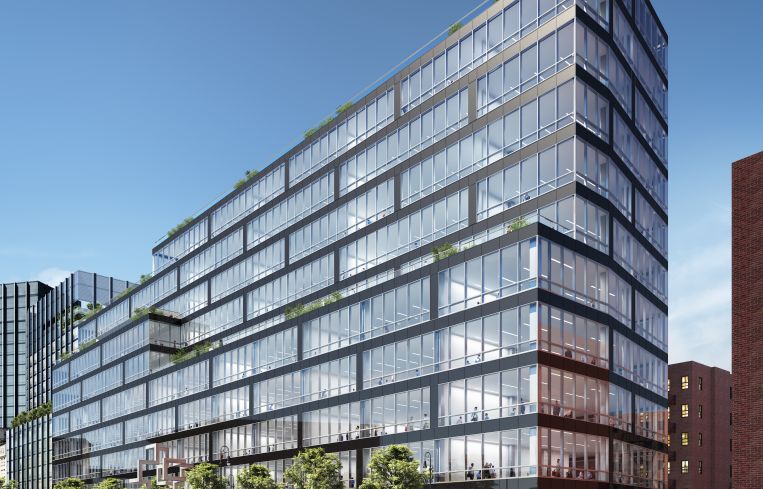
We have seen a major shift in the once-scarce life sciences industry in New York City over the last few years. How did we get here, and what is New York City doing to attract more tenants engaged in the studies of living organisms such as biology, botany, zoology, microbiology, physiology, biochemistry and other related subjects?
We sat down with major developers, architects, interior designers, consulting engineers and investors from top firms including SGA, King Street Properties, CBRE (CBRE), Ennead, JB&B and Perkins and Will.
These experts agree that New York City’s infrastructure is in place to create a thriving life sciences industry. Indeed, the city is already a burgeoning hub, with the leaders of each industry segment residing here. What’s more, these experts point out that as technology continues to evolve rapidly, life sciences now apply to all types of businesses, efficiently improving the environment, medicine, health care, agriculture, and much more.
Bringing Life Sciences to NYC
“For many reasons, NYC is the perfect location for life sciences to flourish. There is an incredible network of health care and educational institutions that are developing the talent needed to sustain the industry,” said Matt Malone, practice leader-associate principal of global architecture firm, Perkins and Will.

We have strong universities and research facilities with a large number of talented people in the industry, access to funding, and rules and regulations with zoning requirements that support creating the space needed for the industry to grow.
Transportation is also a major factor. Robert Albro, managing director at Boston-based real estate investment management and development firm King Street Properties, explains, “Part of what drew us to New York City was the transportation infrastructure, which is very robust,” he says. “The subway system is extensive and so highly used that is unlocks a number of neighborhoods the serve as a lab node. Add to that the ferry system. [It] is a unique form of transportation in New York that can connect different clusters around the area, especially Long Island City.”
New York City needs more well-located modern laboratory space to support the growth of the life science industry. Steve Purpura, vice chairman at global commercial real estate services CBRE, says, “Landlords need to create real estate that works for the function of life science and when that happens there will be significant growth in NYC life science cluster.”
New York and Boston-based architecture, interior design, planning, branded environments and Virtual Design + Construction firm SGA’s studio manager Brooks Slocum says, “It’s the establishment of the cluster and available space that will allow these companies to go in and start building that is going to be the key.”
SGA partner Adam Spagnolo agrees: “NYC is in need of graduation space,” he says. “There are some accelerators and incubators but, as the life science startups receive their funding, there is no place for them. There is a lack of options in terms of graduation space or step-out space, which is like coworking for life sciences. The challenge that tenants are facing is that they are then presented with the option of moving to Boston, San Francisco or another cluster with move-in ready space.”
Finding the Core for the Life Sciences Community
Currently, NYC does not have a center for its life sciences community. We have seen developments popping up in different neighborhoods in the city with laboratory space for life sciences work. Don Weinreich, Managing Partner with New York City-based Ennead Architects, says life sciences projects or clusters are growing in the city based on several influences. For one, the availability of development of property isn’t consistent everywhere in the city, so we need to find those areas that can be developed, he says.
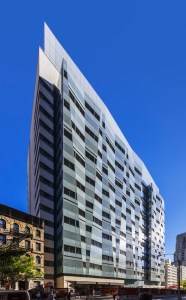
“The other is proximity-based, which is the clusters tend to need to be near other things such as research institutions or the center of finance,” Weinreich says. “There is also the issue of where the zoning allows the assertive uses to occur. The zoning is continuing to evolve as the city constantly updates the zoning resolution. Parts of the city where you can’t develop right now will start to become allowed.”
Steve Purpura, vice chairman at CBRE notes, “The NYC cluster isn’t going to be confined to one location or submarket but rather comprised of multiple projects located on the East Side by the research institutions, on the Upper West Side near Columbia, on the West Side of midtown, and around Penn Station. The cluster will include Manhattan and space in the Boroughs, and everyone will come together to collaborate and for industry events. “
Although life sciences clusters are disbursed in and around the city, the clusters are affecting the neighborhoods in which they reside. Mitchel Simpler, partner, and Chris Horch, associate partner at New York City-based engineering firm JB&B, report that the clusters have been developing organically and the neighborhoods benefit by getting a diverse sector of growth. The neighborhoods receive an influx of new and different talents and different ways of thinking. In addition, life sciences properties also have an economic structure that’s different from a commercial office building in that it may or may not be reversed in a recession.
SGA’s Slocum maintains that the challenge New York City is having is that there are several sub clusters around the city without one main cluster, “the development community can’t make a decision about where this main cluster should go, so New York has several potential sub clusters without a core. In the main Life Science cities, it starts in one area and as the demand for space surges the sub clusters can grow. [However], once the clusters do start, the neighborhoods grow exponentially in regard to life sciences clusters.” One caveat: They need to be near the universities to some degree and have access to a talent pool, he says.
Although a surrounding neighborhood compared to Manhattan, Long Island City has also seen exponential growth. King Street Properties and Perkins and Will both note the symbiotic relationship between the community and life sciences industries.
King Street Properties managing director Robert Albro says, “Long Island City has many positive attributes we look for including numerous public transportation options, workforce housing, and zoning that allows for life science. There is an abundance of existing structures well suited for a conversion to lab as well as availability of sites that can accommodate out of the ground construction. Both are needed to establish a cluster.”
Perkins and Will’s Malone says, “There is an energy to find ways the local CUNY [City University of New York] affiliate can provide industry-supported job training for the support roles and positions that are needed to support the life-sciences industry in Long Island City.”
Shifting Work
As the shift in the location of these clusters of life sciences developments takes place in different neighborhoods in and around the city, we are also seeing a change in the way life sciences work is done. Weinreich of Ennead Architects says, “The emerging and current workforce has a tendency and strong desire to live in the city because of the lifestyle people enjoy in the city. The clusters are almost being driven by the shifting nature of the workforce as much as the location.”
Weinreich continues, “When you get into these dense urban situations, you have this incredible urban compression where you are bringing all of these different communities into very close proximity with each other, which creates a lot of opportunities for intellectual exchange.”
Simpler and Horch of JB&B say the type of research being done is not the traditional heavy chemistry type of work. The life sciences are now a much broader array of research. Some of it is computational, where workers are sitting in front of computer screens and they develop a process and then go out and validate in a lab. The amount of wet lab space is becoming less and less, according to the duo. Technology is also playing a greater role in the research component and has helped immensely because it allows researches to perform their work in buildings that are not necessarily designed to host the kind of heavy infrastructure that might be necessary for a traditional laboratory.
The impact technology has on the type of work that life scientists are doing today is significant. With the impact of artificial intelligence, big data, and blockchain, technology is becoming an integral part of how scientists conduct their work. Spagnolo and Slocum of SGA agree: “Even five years ago you would have seen twenty-five percent office and seventy-five percent lab space; today we are looking at more of a fifty-fifty split between lab researchers and data scientist.”
Expanding the Footprint
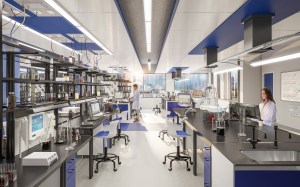
As technology and life sciences become more integrated, we also are seeing an expanded footprint for the life sciences community in New York from a real estate perspective. Albro of King Street Properties says, “The key is building life science space — a lot of people in New York are talking about it, however, one of the keys is building on a speculative basis, meaning you aren’t necessarily going to have an anchor tenant when you start developing a building.”
Life science tenants tend to be looking a little bit near term, seeking space that’s available in six to 12 months. Anything longer than that is too far out on their horizon, according to experts. King Street Properties is building a 266,000-square-foot building with robust and resilient infrastructure at 45-18 Court Square in Long Island City, with the conviction that the tenants are out there and eager to populate this type of building.
With the need for working space to include the life sciences community in New York City, experts say it’s important that we have the space available for tenants as the demand for these types of spaces increases. The demand, in fact, is expected to continue to increase rapidly and significantly in the near future. Simpler and Horch of JB&B report that the key will be to make certain that the real estate community is ready to accommodate the significant growth in life science tenants.
Malone of Perkins and Will says, “At this point, it’s likely that we’re going to address the need for more space in New York via renovations and retrofits to existing building stock as opposed to new, ground-up developments.” That means developers and their consultants will have to navigate zoning issues.
“The city has issued clarification of zoning and the allowable uses in certain zones, which allows for a lot more building stock in even more strategic locations to be considered,” according to Malone. “Of course, you also need to strategize on how to get the infrastructure needed to create a lab-capable space from an existing building. It will never be the case that one-size-fits-all when it comes to renovating for life sciences.”
Opportunities, Trends and Challenges
With this new industry segment expanding rapidly in New York City, it can bring a great range of opportunities, trends and challenges. Because demand now includes the life sciences community, the real estate industry must find the right balance to incorporate working space fast to stay ahead of the curve while at the same time being mindful of their investments, experts say.
Purpura of CBRE says, “In order to maintain the explosive growth of the life sciences industry, new life sciences labor pools need to be identified. We believe that those will be in urban clusters, similar to where the tech companies have gone to grow. When the life sciences companies need to scale and get more people, they can’t just get them all from Boston and San Francisco; they are going to look to places like NYC for expansion. When you think about how much space the tech companies now occupy in NYC compared to 10 years ago it puts the potential opportunity in Life Science in perspective and many savvy developers are trying to get ahead of the curve.”
Malone of Perkins and Will points out that “New York City is the No. 2 recipient of NIH [National Institute of Health] grants in the country. That funding is typically awarded to institutional research. Those grants are smaller increments and typically prescribed to be applied to the research specifically.”
However, when startups come out of incubation, Malone says, or a tool or process comes out of a health care institution’s translational efforts, they’re often coming from an environment where their space needs are met by the institution, or they have been leasing space on a lineal-foot basis with a short-term, subsidized lease as incentive. That scenario limits a startup’s growth and the amount of time they can spend in a space.
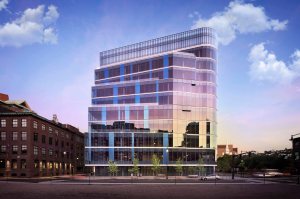
“The result is unsophisticated leasing entities who need to find useable lab space in a short time,” Malone says. “These are people focused on their science — not the process of design and construction. The demand drivers are there to offer flexible, turnkey solutions that are scalable. But if a developer is going to make turnkey labs viable, the design has to be malleable enough to accommodate different tenants.”
Weinreich of Ennead Architects says, “Being able to bring life sciences space online very quickly is both a challenge and an opportunity because nobody wants to wait around for the space to be designed and built. The faster we can bring it online, the better. We have lots of techniques we can use to develop in that regard such as fast-track, design-build methodologies that we do, as well as the adaptive reuse of existing buildings that can save about a year of time.”
As start-up companies grow and the lack of available space for life sciences companies with 100 employees or greater is limited, New York City will need to adapt. Slocum of SGA says, “The next round of buildings that get developed are going to have to recognize the requirements of the talent that the life science companies are trying to attract, because all of the tech companies are providing a more enticing work environment for their employees.” As technology becomes a major part of life sciences, these buildings and the industry will have to attract them at the same level or greater.
Attracting Investors and New Talent
King Street’s Albro says, “Nationally, life sciences have gotten a lot of attention and NYC has entered that discussion.” Given where we are in the cycle, there’s risk, he adds, but also significant potential for a life science node to take root in New York City.
Simpler and Horch of JB&B note that investors seeking portfolio and geographic diversity are coming down from Boston, Cambridge and La Jolla and investing in New York City. As a result, they are attracting talent that would otherwise have to flee the city after they graduated out of their institutional or incubator home. Instead, these investors are coming here and putting down roots to keep the talent here.
Purpura of CBRE believes genomic research has had a major impact on attracting investors and talent to New York and says, “The ability to do virtual research allows scientists to go back and look at research that they have done previously and apply new technology towards a better way to engineer drugs or therapy.”
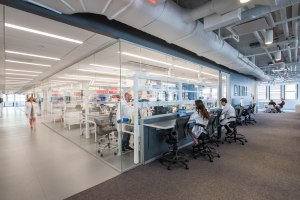
Influencing New Developments
Weinreich of Ennead Architects says there’s a very unique lab technology in New York — the high-rise lab. “Under most building codes, it’s not feasible to construct a high-rise fume hood intensive laboratory because the concentrated chemicals that are allowed,” he explains. “The building code regulations allow you to build high-rise laboratories. This influences an unusual outcome. You see all these very cool laboratories coming up in New York City. We are designing many of them and you just don’t see that elsewhere.”
But there’s also a learning curve in New York City, given the newly expanding life sciences sector. Even the most sophisticated owners and developers are learning how these buildings function, how to generate growth, and how the financing works from the hard costs to the set costs, all of which is new to this type of development in New York City. Spagnolo of SGA says, “developments in this market have to do with being able to be near other likeminded groups. Building anywhere in America wouldn’t work as a life science building unless it’s connected to universities and has funding and all the other pieces that are going to make the development successful.”
King Street Properties’s Albro maintains that life science tenants are similar to tech tenants in terms of the amenities they want. “They want transit access and a vibrant neighborhood with restaurants, fitness and bike storage, and all of the same things a tech tenant wants,” he says. “When people look at new buildings, they are looking at creating cool common space and a more innovative experience for tenants.”
The Future of Life Sciences
As the life sciences industry grows in New York City, we will need to adapt to the needs of these developments and tenants. Technology and life sciences go hand-in-hand and, as technology advances, so will life sciences.
Currently, we do not have enough space for this growing community. As small startups grow into larger companies, we will need to create space that will accommodate these growing businesses. As the life sciences sector matures and grows in New York City, we will also need to keep in mind what talented life sciences professionals are looking for as this sector grows to stay competitive and keep them in the city versus looking elsewhere.
Life sciences professionals are not necessarily looking for traditional laboratory space anymore. They want to be located in easily accessible neighborhoods that are and near like-minded professionals to collaborate with. “We need to provide space in those locations that are highly desirable to an industry that needs labor,” says Purpura of CBRE.
As the life sciences community is still very young in New York, it provides the opportunity for growth. Where other cities, such as Boston and San Francisco, are running out of space to fit life sciences, New York is just beginning to implement pre-built space for this type of tenant.
“The city of Boston has 600,000 people in total; that’s a third of the size of Manhattan. [Yet] they have 10 times more built laboratory space because they started earlier,” according to Weinreich of Ennead Architects.
There is room to grow the life sciences industry as the interest in this market is great in New York. The need for life sciences are connected to companies funding them. This wave of business wants to come to New York, the experts point out, noting that we just must gain a better understanding and be better prepared for what the life sciences community needs to thrive here. This is a very exciting time for the New York City commercial real estate industry.


